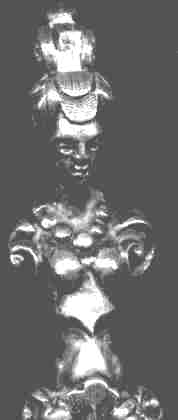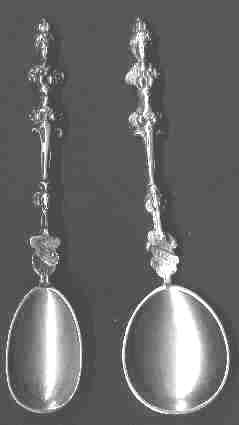
I have been showing this spoon which I believed came from the Centennial Exhibition in Philadelphia, 1876. Another slightly different version has now been discovered (see below). The Centennial Exhibition was about fifteen years before the start of the souvenir spoon movement in the United States and at the very beginning of the Art Nuevo design period in the USA.


This very unusual looking spoon has been in my collection for a long time. It has a heavy cast sterling handle and an egg shaped bowl. The marks on the back indicate that it was made in London in 1876 by a silversmith using the code CB in intertwined circles, but I have been unable to attribute it with my books.
The highly three dimensional bust of Queen Victoria shows her famous "hair bun"and her bosom is highly exaggerated.
About half way down the handle is a male face which I suspect is Prince Albert. Below that is a strange design element which I have not been able to identify.
The basic design elements of the spoon are clearly Art Nuevo in style but they do not yet exhibit many of the traits that we have come to expect from the Art Nuevo movement. But since this was early in the Art Nuevo phase, that is understandable.
I am guessing that it is related to the Centennial Exhibition because of the date and because of its highly unusual nature.
I now wonder if my interpretation of this spoon is correct. Another example which is very close to the above has been discovered. The handles of both are cast, and there are some small differences, thus they are probably not from the same mold and probably not a direct reproduction. In addition, the bowls are different and the marks on the new one indicate that it is from one of the Scandinavian countries. I have reproduced them side by side.

new one on right.
In addition the new one has the number "1635" engraved on it.
(This spoon was NOT made in 1635)
The similarity is too close to suspect that they were made totally independently, yet they are not exact copies. The fact that they bear hallmarks from different countries is also confusing to me. It may be possible that they are Victorian era reproductions of a 1635 spoon or something to that effect, but that is speculation.


left: marks from first version
right: marks from second version
I have now discovered that an enameled version of this spoon is also available. I guess it is less rare than I thought.
If anyone can offer help, please advise me.
BIOGRAPHY: QUEEN VICTORIA recounts how halfway through her reign, her beloved Albert died and struck her with such grief she was not seen in public for three years. But she recovered and reappeared with the assistance of Benjamin Disraeli, the new prime minister whose personality and politics she favored. Under Disraeli's leadership, Britain gained control of the Suez Canal in 1875 and Queen Victoria was proclaimed empress of India a year later. Queen Victoria was monarch of Great Britain during the greater part of the 19th century and became the symbol of the empire's peace and prosperity. She lived until 1901 but her Victorian Age lasted until 1914 when Europe was plunged into the Great War. She was succeeded on the throne by her son Edward VII.
Return to Spoon World Index